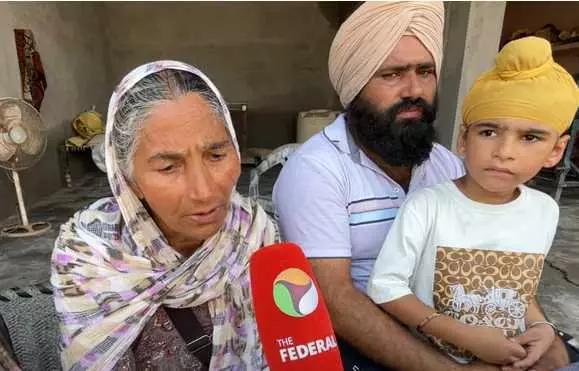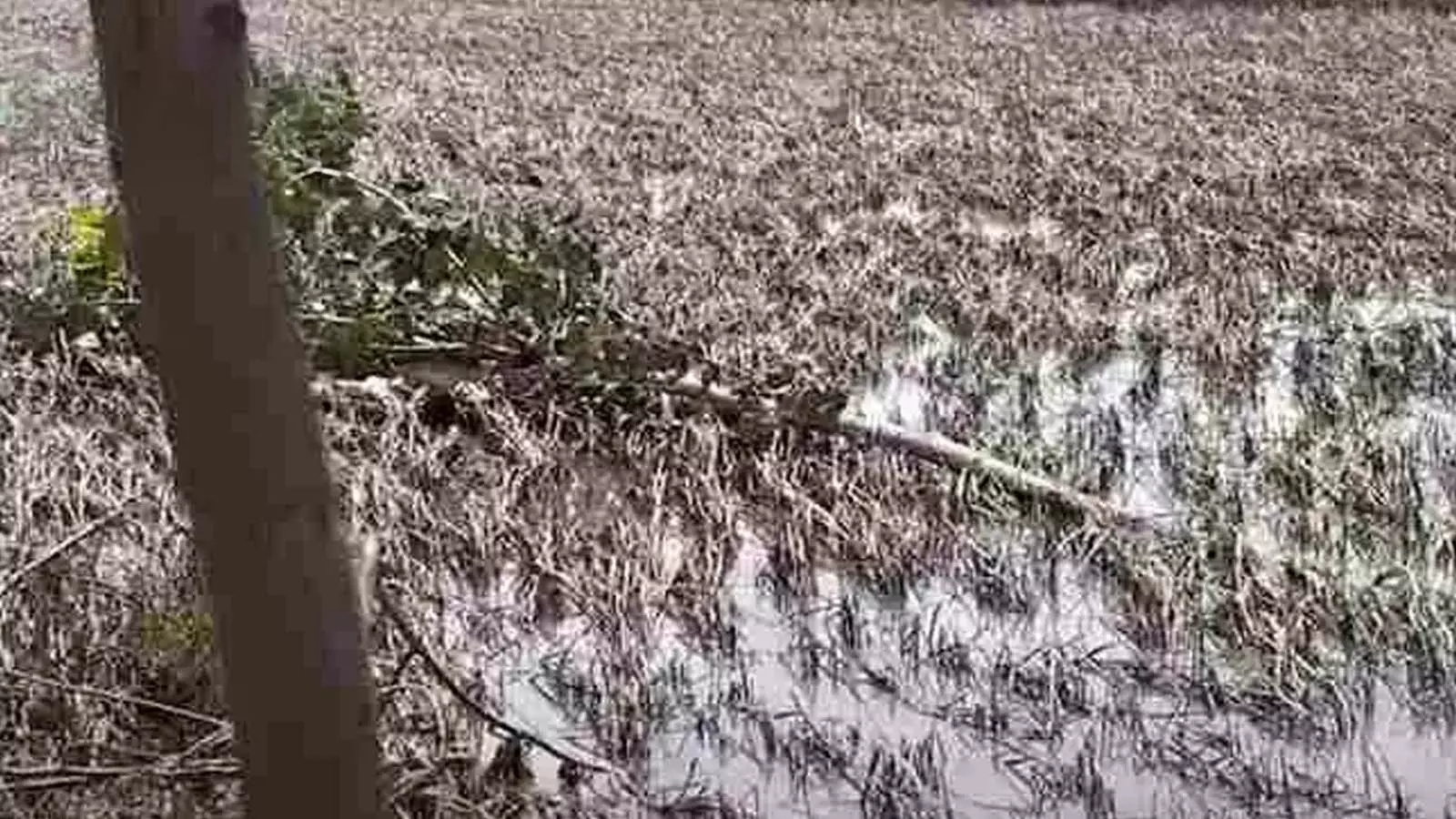
- Home
- India
- World
- Premium
- THE FEDERAL SPECIAL
- Analysis
- States
- Perspective
- Videos
- Sports
- Education
- Entertainment
- Elections
- Features
- Health
- Business
- Series
- In memoriam: Sheikh Mujibur Rahman
- Bishnoi's Men
- NEET TANGLE
- Economy Series
- Earth Day
- Kashmir’s Frozen Turbulence
- India@75
- The legend of Ramjanmabhoomi
- Liberalisation@30
- How to tame a dragon
- Celebrating biodiversity
- Farm Matters
- 50 days of solitude
- Bringing Migrants Home
- Budget 2020
- Jharkhand Votes
- The Federal Investigates
- The Federal Impact
- Vanishing Sand
- Gandhi @ 150
- Andhra Today
- Field report
- Operation Gulmarg
- Pandemic @1 Mn in India
- The Federal Year-End
- The Zero Year
- Science
- Brand studio
- Newsletter
- Elections 2024
- Events
Punjab floods: How Ravi’s fury, embankment collapse brought calamity to farmers
Villages in Punjab’s Amritsar district were devastated after the Thusi embankment collapsed last month. Crops worth lakhs were destroyed, land buried under river sand and relief left to gurdwaras and volunteers as official aid lagged, alleged locals

On the banks of the Ravi, in the Ajnala tehsil of Punjab's Amritsar district, the story of human pathos left in the wake of the recent flood reads like a catalogue of destroyed livelihoods. On 27 August, farmers in villages such as Machhiwal and Gonewala recalled being woken by the deafening sound of the Thusi embankment bursting open; within hours, standing paddy fields, ready for harvest,...
On the banks of the Ravi, in the Ajnala tehsil of Punjab's Amritsar district, the story of human pathos left in the wake of the recent flood reads like a catalogue of destroyed livelihoods. On 27 August, farmers in villages such as Machhiwal and Gonewala recalled being woken by the deafening sound of the Thusi embankment bursting open; within hours, standing paddy fields, ready for harvest, had turned into muddy lakes or been buried beneath a carpet of river sand. Where there had been shoots and green, there was now refuse and silt.
“That morning was unlike any other. Near my village, Machhiwal, the Thusi embankment gave way with a thunderous crack. The sight of the swollen waters of the Ravi filled us with dread. The entire village watched helplessly as, in the blink of an eye, our standing paddy crops lay ruined by the fury of nature. When at last the water began to recede, it left behind a blanket of river sand across the fields,” recalled Sawanjeet Singh, a farmer. He spoke haltingly, worry lines etched deep upon his face, as he pondered the calamity he was left facing.
A small village in Ajnala tehsil, Machhiwal is barely three kilometres away from the Pakistan border. Family after family here described the same double blow: floodwater destroying the current crop, and river-borne sand rendering the land unsuitable for immediate re-sowing, meaning wheat production this season was uncertain at best. For many smallhold farmers that would not be just a seasonal loss; losing a single crop threatens a year or more of income and could push debt-burderened households into deeper distress.
Touring Punjab’s flood-stricken districts — Ferozepur, Kapurthala, Amritsar, Tarn Taran, and Pathankot — in the first week of September, The Federal Desh team had caught up with Sawanjeet as he stood by the roadside with his family. “Do you want to listen to our tale of anguish?” he asked. Among the group was a six-year-old, whose young face already reflected the weight of loss.
Gesturing toward his sister, Jasroop, Sawanjeet said, “My brother-in-law, her husband, died six years ago of electrocution. And now, the flood has brought further misery for her and her children.” Jasroop interrupted him, her voice taut with despair: “We are ruined. How will we live now? Darkness has fallen before our eyes. There is no other livelihood.”
Talking about the repair work The Federal Desh had seen being done along the Thusi embankment, a bitter Jasroop, claimed it had only been undertaken because of the nearby Border Security Force (BSF) outpost. “Had the outpost not been there, the government would have abandoned the embankment altogether,” she alleged. Her father-in-law, Paramjit Singh, added: “This is sheer negligence of the government.”
Pushed beyond endurance, Sawanjeet, alleged, “The Ravi is our lifeline. But, on the night of 26-27 August, in just eight hours 1.4 million cusecs of water was released. That same volume should have been released in controlled stages over 14 days. The government is solely responsible for this ruin.”

Sawanjeet Singh's family. Photo by Lalit Rai
The same anger against the government was voiced by Gyanpreet Singh, a resident of neighbouring Gonewala village. “The devastation here,” he stressed, “was caused above all by the collapse of the Thusi embankment. It broke in not one, but many points. And government aid? Nothing but words. Had it not been for the langars [community kitchen] and the gurdwaras, things would be far worse.”
Gyanpreet added: “We have had no electricity [then] for 12 days, drinking water is scarce, cattle fodder has run out. Since 27 August, the government has done no more than speak of help.” Asked about the usual size of landholdings in the area, he explained: “Three to four killas [a unit of measurement, one killa equals one acre] on average. Between Gonewala and Machhiwal alone, 500 hectares of crops have been destroyed. Each small farmer has lost at least three to four lakh rupees.”
Also read: How encroachment turns Yamuna floods into Delhi’s cycle of displacement
Local volunteers, gurdwaras and langars filled the alleged breach left by slow-moving official relief. In the worst-hit border subdivisions, villagers and visiting volunteers from neighbouring states worked tirelessly to plug breaches in the embankment with sandbags, jute sacks and whatever engineering improvisation they could manage. The army’s rubber dinghies and helicopter sorties rescued stranded people and livestock; but even where lives were saved, the scale of agricultural damage was reportedly being described by officials and analysts as one of the worst in decades.
According to Sudhakar Singh, a member of the management committee of the gurdwara in Ranonpur Kalan in Rupnagar district (known locally as Ropar), the spirit of cooperation was a part of the culture of Punjab. “Whenever there’s been a disaster, every Punjabi has stood up against it. The Punjab government is providing MNREGA workers [to strengthen embankments across the state]. Apart from that we are making our own arrangements for relief.”
In the wake of the flood, the Centre announced an initial aid package of Rs 1,600 crore and the Punjab government notified compensation, including up to Rs 20,000 per acre for flood-hit farmers, alongside aid for families of the deceased. The state government had also announced help in removing sand from the fields. But those hit by the flood found little comfort in these efforts.
Engineers and independent experts The Federal Desh spoke to pointed to a catastrophic synchronisation this season: heavy rainfall in the Himalayan catchments sent unprecedented inflows into Bhakra, Pong and Ranjit Sagar reservoirs; gates were opened to protect dam integrity, but the timing and volume of water release, together with unregulated tributary surges, meant water converged downstream in a way that left embankments and barrages unable to handle the pressure, they said. The result was sudden, forceful surges through the Ravi and Sutlej systems — events that reports claimed officials acknowledged exceeded safe carrying capacities in many reaches. Reports also cited weakened embankments, floodplain encroachment and obstruction of natural drainage as other reasons for the flood.
Also read: Samudaya at 50: Why Karnataka’s theatre collective must reinvent to stay relevant
At Ranonpur Kalan many had gathered at the village gurdwara for relief and solace. Thousands of sandbags were stacked inside as a pre-emptive measure, to be distribute if required. Among those present was Karnveer Singh, a functionary of the Bharatiya Kisan Union (BKU, Behramke), a faction of the larger Bharatiya Kisan Union, an organisation involved in the farmers’ protests of September 2023 against now-repealed farm laws introduced by the Narendra Modi government at the Centre.

Asked if the Bhagwant Mann-led Aam Aadmi Party government at the state was providing help, the people broke into bitter laughter: “Which government? Punjab is being run from Delhi — by Kejriwal [AAP national convenor Arvind Kejriwal] and Sisodia [party leader Manish Sisodia],” Karnveer alleged. He added: “This government is worse than the Akalis [Akali Dal] and the Congress. Old wine in a new bottle. Pointing to the sandbags, he claimed, “These precautions are the work of ordinary people. Without us, matters would be much worse. More than 250,000 acres of crops lie ruined.”
As the talk veered toward the farmers’ movement, Prem Singh, Komal Singh, Jang Singh, and Sudhakar Singh of BKU Behramke spoke, almost in unison: “Modi has wrecked everything.” Asked if they had spoken to CM Mann, they dismissed it: “All theatre. The Centre treats Punjab as a stepchild because they know the BJP will win nothing here.”
Yet even in despair, a note of defiance prevailed: “The more you oppress Punjabis, the louder their voices rise," said one.
